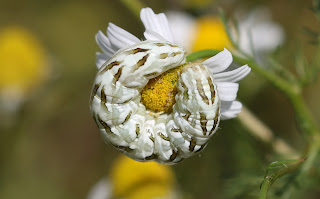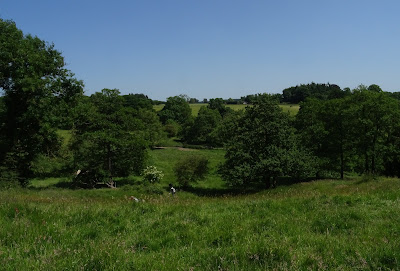Wednesday 14th June 2023, Fordhall Farm
Fortunately, we were not subjected to a shark attack in the middle of the country, but came across this caterpillar curled around a flower head.
 |
| Photograph: John Martin |
It is the rather attractive larva of a Chamomile shark.
It is safe to go into the water!
Our visit was to Fordhall Farm, an organic livestock farm near to Market Drayton. It is a community owned farm, but it has been farmed by the same family for a long time. More information about the farm can be found by following this link Fordhall Organic Farm.
We gathered in the car park and, as usual, one or two of us was dallying. When this happens those who are ready either stand around waiting, patiently, or wander off (not too far) and start seeking out things of interest.
And the things of interest on this occasion was a clutch of Green shieldbug eggs on a plant in the garden. Some had hatched and others were close to hatching, there were even a couple of tiny 1st instar nymphs hanging around.
 |
| Photograph: David Williams |
When we returned later in the day to go home, we checked the progress of the eggs but nothing had changed.
We had been asked to look at three areas, so we made our way to the first – Cottage Field.
This is an area of grassland used for hay.
We spent the morning, under the hot beating sun, in this large field.
Joining us was a member of the Fordhall team who took photographs of us during the morning to use in their publicity efforts. We have been given a copy of the photographs and permission to include a selection in this report.
So. Here we are in full action mode.
.JPG) |
| Photograph: Fran Lant |
.JPG) |
| Photograph: Fran Lant |
.JPG) |
| Photograph: Fran Lant |
.JPG) |
| Photograph: Fran Lant |
.JPG) |
| Photograph: Fran Lant |
.JPG) |
| Photograph: Fran Lant |
.JPG) |
| Photograph: Fran Lant |
.JPG) |
| Photograph: Fran Lant |
.JPG) |
| Photograph: Fran Lant |
.JPG) |
| Photograph: Fran Lant |
Right, that’s the people, but what about the wildlife that we found in Cottage Field?
Well, here are a few of the beasts that we found:
The larva of a Pine ladybird;
.jpg) |
| Photograph: David Williams |
A chafer, not the very common Garden chafer but a Welsh chafer;
 |
| Photograph: Jim Almond |
A Short-cloaked moth;
 |
| Photograph: David Williams |
A Yellow shell moth;
 |
| Photograph: Jim Almond |
And a long horn beetle, Rutpela maculata.
 |
| Photograph: Jim Almond |
By now we had worked our way across the field and came to a gap that led into the second area that we were asked to focus on, Mill Meadow.
As it was now lunchtime we sought the shade of a large oak and settled down to our refreshments.
Well, most of us did.
Others continued scouring the area.
And turned up:
A Mother Shipton moth;
 |
| Photograph: Jim Almond |
A pair of Meadow browns involved in ensuring the continuation of the species whilst a third appears to be looking on;
.jpg) |
| Photograph: Jim Almond |
And a Large skipper, distinguished from the similar Small and Essex skippers by the paler patches on its wings.
 |
| Photograph: Jim Almond |
Refreshed we continued the short descent into Mill Meadow pausing to admire the nymph of a Blue shieldbug.
 |
| Photograph: David Williams |
Finally arriving in the meadow, we spread out to see what the meadow, which borders the River Tern, supported.
This time of year signals the arrival of ladybird larva. We had already found 14-spot and pine ladybird larvae in Cottage Field and Mill Meadow provided a third species, 2-spot.
.jpg) |
| Photograph: David Williams |
The presence of the river probably contributed to our finding of several damselflies:
A Common blue damselfly;
 |
| Photograph: Jim Almond |
A Beautiful demoiselle;
And a Banded demoiselle;
On a muddy section of the river bank we found a greenish beetle with curious circular markings, Elaphrus riparius.
.jpg) |
| Photograph: David Williams |
Time was passing and we still had to visit a third area of the farm, Three Ponds. It was quite a walk to get there from Mill Meadow. Cajoling everyone to leave the meadow was not a straightforward task as the first obstacle was a short steep climb.
As a straggling line we managed to get close to the entrance to the Three Ponds area where we were forced to congregate to decide if the locals were friendly.
They were.
And they were behind a fence.
We edged past them and onto the ponds.
Here is one of them:
To be frank we were quite tired by this time and the heat was oppressive. Quite a bit of time was spent sitting on the bench or the ground, but we did some exploration.
A large fly was spotted doing what some of us were doing, resting. It was eventually identified as a Horse fly, Tabanus autumnalis.
.jpg) |
| Photograph: David Williams |
And we added to our collection of records of ladybird larva by finding this larva of Coccidula rufa.
.jpg) |
| Photograph: David Williams |
We left the ponds and made our way back to the farm buildings passing an impressive large thistle on the way, which I was informed was a Musk thistle.
Back in the shade of farm buildings we were treated to drinks and lots of cake. After which we waddled home.
Other News
The Shropshire Spider Group joined forces with the Shropshire Botanical Society during a visit to Llynclys Quarry. This is a vast working quarry, but some areas that had been worked out had been restored and a couple of these were the focus of the group’s attention.
Here are photographs of some of the insects that were found during the visit:
A very impressive Lunar Hornet clearwing moth;
.jpg) |
| Photograph: David Williams |
.jpg) |
| Photograph: David Williams |
Another clearwing moth, this time a Six-belted clearwing;
 |
| Photograph: Nigel Cane-Honeysett |
A 14-spot ladybird;
 |
| Photograph: Nigel Cane-Honeysett |
And finally a Mullein moth larva.
 |
| Photograph: David Williams |
A visit to Meathrop Moss in Cumbria found a good number of Large heath moths. These were very active and did not settle for long. But, eventually, one did land close by and allowed itself to be photographed.
 |
| Photograph: Bob Kemp |
Lastly a visit to see the Silver-studded blues at Butterfly Conservation’s Reserve at Prees Heath provided the opportunity for these stunning photographs of the butterfly in flight to be taken.
.jpg) |
| Photograph: Bob Kemp |
.jpg) |
| Photograph: Bob Kemp |
As well as seeing a pair thinking about attempting to preserve the species.
.jpg) |
| Photograph: Bob Kemp |
Thank you to Fordhall Farm for giving us permission to enjoy ourselves and the excellent refreshments. My immense gratitude to the photographers for their images to illuminate this tale.
.JPG)
.JPG)
.JPG)




.JPG)









.jpg)
.jpg)








%20DW%202023-06-09.jpg)

























